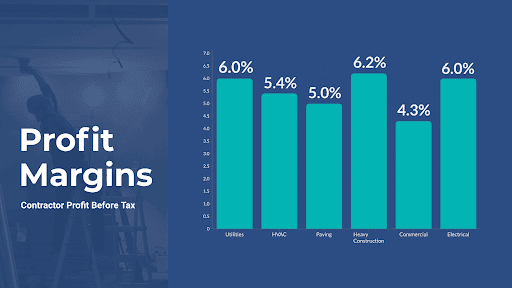Accurate Time Tracking Is So Much Easier With Workyard
The average profit margin for Construction companies is 5%. That leaves very little room for error.
With 64% of all small businesses failing within the first ten years—and 82% of those due to cash flow mismanagement—you need to know how to increase profit margin in construction to build a better, more resilient company.
How To Increase Profit Margin in Construction
Depending on the type of construction, profit margins range from 4.3% to 6.2%. And that makes sense: construction is a lean industry, and no one’s giving work to the highest bidder.

Construction companies only see as little as five cents of profit for every dollar they bring in, which doesn’t provide a lot of cushion when something goes wrong.
Since you can’t just charge more, managing profitability largely means managing expenses. And that starts with your most significant cost—your labor.
Strategy #1: Reduce Labor Costs by Improving Time Tracking
About half of the money a construction company brings in goes right back out to labor. And that labor isn’t always used effectively. If you can reduce your labor costs, the savings become pure profit.
|
|
IMPROVE YOUR TIME TRACKING You can reduce your labor costs by improving your time tracking, leaving you with a better bottom line. |
So, what’s holding you back? We’ve outlined a few common issues below—and a fix.
Common Roadblocks To Improving Time Tracking
- Construction time management is complex. You need to track multiple workers, sites, and schedules.
- Often, there isn’t a dedicated site supervisor to manage workers or supervise time spent on tasks.
- Most workers are terrible at managing and reporting their own time.
Fix: Use construction timesheet software to more accurately track your crews hours and location. Many contractors save tens of thousands of dollar per month just by implementing a time tracking software package.
Strategy #2: Eliminate Wasted Time Coordinating Work
There are only 24 hours in the day. By eliminating wasted time, you can focus on growing and strengthening your business.
|
|
ELIMINATE WASTED TIME COORDINATING WORK Countless hours are spent on paper schedules, back and forth texts, and phone calls each day to coordinate work. It’s no wonder that the average construction worker only spends 70% of their time actually doing work. |
Efficiencies are lost in construction because for many companies it’s nearly impossible to get everyone on the same page. You know what I’m talking about—the same fragmented conversations seem to need repeating every day. As your company’s most important resource, your team’s time should be dedicated to productive work, not endlessly trying to figure out what they’re supposed to be doing.
Fix: To eliminate all of that wasted time coordinating work, leverage a job scheduling app to consolidate communications into one place.
Strategy #3: Lose Those Paper Processes
Finally, if you’re still scribbling down notes on paper, you’re losing money.
|
|
LOSE THOSE PAPER PROCESSES At every construction company, someone must collect data, like receipts, timesheets, plans, and schedules. Handling that work on paper wastes time and money—and it’s prone to countless data entry errors. |
From the initial project costing to late-stage re-works, your processes are what define your profitability. By replacing paper processes with a digital solution, you can:
- Unlock profits with more accurate time tracking.
- Increase the accuracy of job costing analysis.
- Improve construction productivity.
Fix: With streamlined processes for data collection and entry, you can reduce mistakes and re-works, minimize your overhead, and increase your profit margin.
Secure Your Company’s Future Through Increased Profit Margin
Let’s be realistic. Increasing your profit margin in construction isn’t just about making more money. It’s about securing the future of your business.
Approximately 50% of small businesses fold within the first five years, and the rate among construction companies can be even higher.
When your profit margin is slight, your business is vulnerable; any incident can become a catastrophe. By improving your cash flow and building a buffer, you’ll create a more resilient business.
Did you find this post helpful? Please rate it!




 (No Ratings Yet)
(No Ratings Yet)

